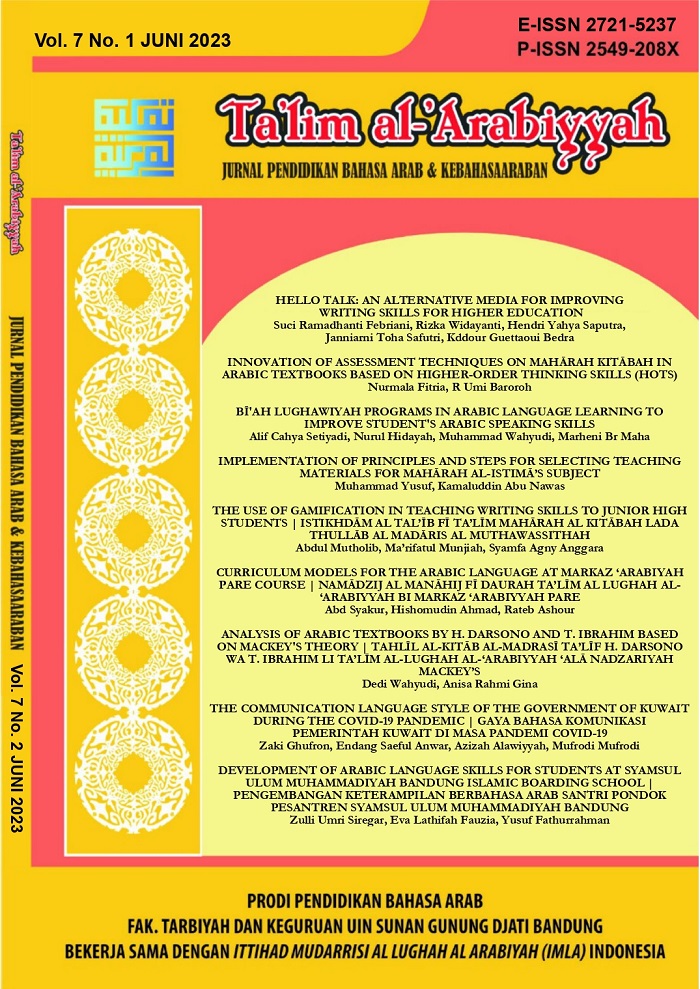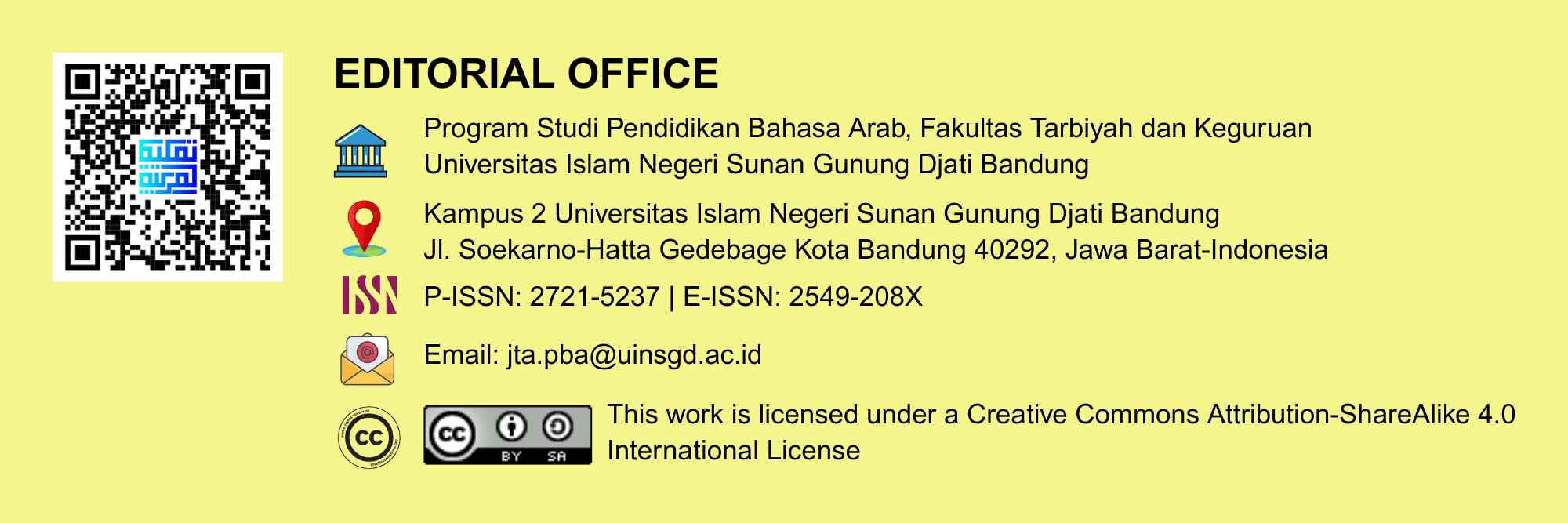Analysis of Arabic Textbooks by H. Darsono and T. Ibrahim Based on Mackey's Theory | TahlÄ«l Al-KitÄb Al-MadrasÄ« Ta’lÄ«f H. Darsono Wa T. Ibrahim Li Ta’lÄ«m Al-Lughah Al-‘Arabiyyah ‘AlÄ Nadzariyah Mackey’s
DOI:
https://doi.org/10.15575/jpba.v7i1.24847Keywords:
Curriculum 2013, Mackey's Theory, Textbook AnalysisAbstract
Changes in the curriculum certainly have their effects, one of which is the use of textbooks used in education. Textbooks are one of the essential elements in learning because they are learning materials and sources of guidance in them. There are many written textbooks based on the 2013 curriculum, and among the textbooks that are widely used in schools are Arabic books by H. Darsono and T. Ibrahim for grade VIII in Tsanawiyah. This study aimed to determine the selection of material, its arrangement, presentation, and repetition in Arabic textbooks for grade VIII in Madrasah Tsanawiyah according to the 2013 curriculum. The research method used in this study is the analytical descriptive method. The type of data used is qualitative data because the source of data in this study is a textbook written by H. Darsono and T. Ibrahim to teach Arabic until eighth grade in Islamic High School. The study results are 1) Selection of subjects in textbooks written by H. Darsono and T. Ibrahim to teach Arabic for grade VIII at Madrasah Tsanawiyah, according to educational objectives, student levels, and specified time. 2) The material's structure includes structural and moral grouping and the education arrangement from accessible material to complex material. 3) The presentation of articles includes discriminatory procedures and intensive procedures. 4) Repetition in this book is based on listening, speaking, reading, and writing skills.
References
Aflisia, N., & Hazuar, H. (2020). Pengembangan Bahan Ajar Bahasa Arab Berbasis Pendekatan Komunikatif. Arabiyatuna : Jurnal Bahasa Arab, 4(1), 111–130. https://doi.org/10.29240/jba.v4i1.1380
Albab, D. U. (2021). Analisis Buku Ajar Bahasa Arab MI Kelas IV Kurikulum 2013 Terbitan KEMENAG RI Tahun 2020. Jurnal Al-Maqayis, 5(1), 1–17. https://doi.org/10.18592/jams.v6i2.5217
Bahy, Moh. B. A., & Taufiq, M. A. (2022). Analisis Buku Ajar Bahasa Arab Tingkat Madrasah Ibtidaiyah Perspektif Amani dan Awatif. Taqdir, 7(2), 245–256. https://doi.org/10.19109/taqdir.v7i2.10175
Ediyani, M., Anwar, K., Husaini, H., Zuhaimi, R., & Hidayat, T. (2020). The Analysis of Arabic Learning Materials in Al-‘Arabiyah Baina Yadaik Book with the Principle of Material Development Approach. Budapest International Research and Critics Institute (BIRCI-Journal): Humanities and Social Sciences, 3(2), 965–974. https://doi.org/10.33258/birci.v3i2.924
Fallucchi, F., Ghattas, B., Spielhaus, R., & De Luca, E. W. (2022). Digital Qualitative and Quantitative Analysis of Arabic Textbooks. Future Internet, 14(8), 1–14. https://doi.org/10.3390/fi14080237
Faoziyah, L., & Izzah, N. (2021). Analysis of Arabic Language Textbooks for Madrasah Aliyah Class XI Based on the 2013 Curriculum | Analisis Buku Ajar Bahasa Arab Madrasah Aliyah Kelas XI Berdasarkan Kurikulum 2013. Mantiqu Tayr: Journal of Arabic Language, 1(2), 117–132. https://doi.org/10.25217/mantiqutayr.v1i2.1480
Farobi, M. A., Al Azmi, F., Hidayatullah, A. D., & Daroini, S. (2022). Analisis Buku Bahasa Arab Kelas 10 Direktorat Kurikulum Sarana Kelembagaan dan Kesiswaan (KSKK) Tinjauan Konten Berdasarkan Teori Mackey. Al Mi’yar: Jurnal Ilmiah Pembelajaran Bahasa Arab dan Kebahasaaraban, 5(2), 303–322. https://doi.org/10.35931/am.v5i2.1388
Hadi, N. (2018). Analisis Isi Buku Ajar Bahasa Arab (Pendekatan Saintifik Kurikulum 2013) Kelas I Madrasah Ibtidaiyah Terbitan Kementerian Agama Republik Indonesia 2014. Ijaz Arabi Journal of Arabic Learning, 1(1), 37–51. https://doi.org/10.18860/ijazarabi.v1i1.4930
Hidayat, R., & Ainul Muna, A. F. (2023). Ansyithah al-Lughawiyyah li Tarqiyah Maharah al-Kalam bi Ma’had Darussalam Gontor. ’Arabiyya: Jurnal Studi Bahasa Arab, 11(02), 333–350. https://doi.org/10.47498/arabiyya.v11i02.1389
Husna, I., Azkiya, H., Febriani, S. R., Rahmawati, R., & Kustati, M. (2022). The Analysis of Arabic Language Textbooks for Class II Elementary School. Lectura : Jurnal Pendidikan, 13(2), 234–245. https://doi.org/10.31849/lectura.v13i2.10417
Jalaludin, A., Maesyaroh, A., & Ezriyati, E. (2022). Analysis of The Arabic Textbook for Class IV of Madrasah Ibtidaiyah by Sri Kuryati. Tadris Al-’Arabiyyah: Jurnal Pendidikan Bahasa Arab dan Kebahasaaraban, 1(1), 43–53. https://doi.org/10.15575/ta.v1i1.17567
Jamil, H., & Agung, N. (2022). Tantangan Pembelajaran Bahasa Arab Di Era Society 5.0: Analisis Pembelajaran Bahasa Arab Berbasis Aplikasi Interaktif. Alibbaa’: Jurnal Pendidikan Bahasa Arab, 3(1), 38–51. https://doi.org/10.19105/ajpba.v3i1.5536
Khaizal, N. F. M., Nasir, M. K. M., Rahimi, N. M., & A-Rahman, F. (2021). Speaking Sub-Skills Exercise and Its Teaching Techniques: Document Analysis of Arabic Textbooks. Creative Education, 12(09), 2159–2166. https://doi.org/10.4236/ce.2021.129165
Lewicka, M., & Waszau, A. (2017). Analysis of Textbooks for Teaching Arabic as a Foreign Language in terms of the Cultural Curriculum. Universal Journal of Educational Research, 5(1), 36–44. https://doi.org/10.13189/ujer.2017.050105
Mabrurrosi, M. (2020). Analisis Buku Ajar Bahasa Arab Karya Dr. D. Hidayat. Al-Irfan : Journal of Arabic Literature and Islamic Studies, 3(2), 237–257. https://doi.org/10.36835/al-irfan.v3i2.4016
Mamnunah, M., Abdurrahman, M., & Sopian, A. (2021). The Error Analysis of Arabic Grammar in The Kalamuna Book. Arabi: Journal of Arabic Studies, 6(2), 158–166. https://doi.org/10.24865/ajas.v6i2.351
Mokoagow, A. F., Iman, M. N., & Miolo, M. I. (2021). Telaah Buku teks Bahasa Arab Madrasah Aliyah (Studi Analisis Buku Ajar kelas 12 KMA 183 Tahun 2019). A Jamiy: Jurnal Bahasa dan Sastra Arab, 10(1), 205–215. http://dx.doi.org/10.31314/ajamiy.10.1.205-215.2021
Muhamad, S. (2022). Telaah Buku Teks Bahasa Arab Madrasah Aliyah. Al-Mashadir, 2(01), 71–84. https://doi.org/10.30984/almashadir.v2i01.253
Pahlevi, R. (2020). Analisis Buku Al-‘Arabiyyah Baina Yadaik Jilid I: Tinjauan Komponen dan Tahap Penyajian Materi Buku Teks Bahasa Arab. al-Ittijah: Jurnal Keilmuan dan Kependidikan Bahasa Arab, 12(2), 157–176. https://doi.org/10.32678/al-ittijah.v12i2.3630
Ramah, S., & Rohman, M. (2018). Analisis Buku Ajar Bahasa Arab Madrasah Aliyah Kurikulum 2013. Arabiyatuna : Jurnal Bahasa Arab, 2(2), 141–160. https://doi.org/10.29240/jba.v2i2.552
Ritonga, A. W. (2021). Analysis of Arabic Textbook “Takallam Bil 'Arabiyyah Volume 6†Based on Mickey’s Theory. Tanwir Arabiyyah: Arabic As Foreign Language Journal, 1(1), 25–32. https://doi.org/10.31869/aflj.v1i1.2534
Rosyadi, S. (2021). Analisis Buku Ajar Bahasa Arab Madrasah Ibtidaiayah Kelas 1 Dari Kementrian Agama Republik Indonesia. Jurnal Al-Maqayis, 6(1), 1–14. https://doi.org/10.18592/jams.v7i1.5241
Siregar, H. H., Moh. Ainin, Muassomah, Dadang Firdaus, & Rendi Pramadi. (2022). Exploring of Arabic Text Book for MA KMA 183 in 2019 Based on Mackey’s Theory and ACTFL Standards. al MahÄra: Jurnal Pendidikan Bahasa Arab, 8(1), 123–152. https://doi.org/10.14421/almahara.2022.081-06
Syaifullah, M., & Izzah, N. (2019). Kajian Teoritis Pengembangan Bahan Ajar Bahasa Arab. Arabiyatuna : Jurnal Bahasa Arab, 3(1), 127–144. https://doi.org/10.29240/jba.v3i1.764
Tausiah, H., Rosita, E., Amanillah, S., & Sauri, S. (2019). Analysis Of Compiling Textbooks For Developing Reading Skills In Arabic Language. EDUTECH, 18(3), 340–347. https://doi.org/10.17509/e.v18i3.17501
Wachdah, R. L. (2020). Evaluasi Buku Ajar Bahasa Arab Kelas X Madrasah Aliyah: Pendekatan Saintifik Kurikulum 2013. Al-Ma’rifah, 17(1), 41–47. https://doi.org/10.21009/almakrifah.17.01.04
Zaenuri, M. (2019). Analisis Buku Ajar Belajar Membaca Kitab Kuning Metode Ibtida’i Karya Mujahidin Rohman. Arabia, 11(1), 191–212. https://doi.org/10.21043/arabia.v11i1.5255
Zun, E. D. F. (2022). Content Analysis of Arabic Language Textbook for Tenth Grade Based On Curriculum 2013. Journal of Arabic Language Studies and Teaching (JALSAT), 2(2), 160–174. https://doi.org/10.15642/jalsat.v2i2.124
Downloads
Published
How to Cite
Issue
Section
Citation Check
License
Authors who publish in Ta'lim al-'Arabiyyah: Jurnal Pendidikan Bahasa Arab dan Kebahasaaraban agree to the following terms:
- Authors retain copyright and grant the journal right of first publication with the work simultaneously licensed under a Creative Commons Attribution-ShareAlike 4.0 International (CC BY-SA 4.0) License that allows others to share the work with an acknowledgment of the work's authorship and initial publication in this journal.
- Authors are able to enter into separate, additional contractual arrangements for the non-exclusive distribution of the journal's published version of the work (e.g., post it to an institutional repository or publish it in a book), with an acknowledgment of its initial publication in this journal.
- Authors are permitted and encouraged to post their work online (e.g., in institutional repositories or on their website) prior to and during the submission process, as it can lead to productive exchanges, as well as earlier and greater citation of published work (See The Effect of Open Access).
![]()
Ta'lim al-'Arabiyyah: Jurnal Pendidikan Bahasa Arab dan Kebahasaaraban is licensed under a Creative Commons Attribution-ShareAlike 4.0 International License.
Based on a work at https://journal.uinsgd.ac.id/index.php/Talim








